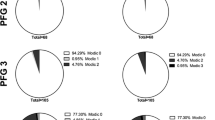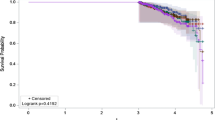Abstract
Purpose
Evolution and progression of disc and endplate bone marrow degeneration of the lumbar spine are thought to be multifactorial, yet, their influence and interactions are not understood. The aim of this study was to find association of potential predictors of evolution of degeneration of the lumbar spine.
Methods
Patients (n = 90) who underwent two lumbar magnetic resonance imaging (MRI) exams with an interval of at least 4 years and without any spinal surgery were included into the longitudinal cohort study with nested case–control analysis. Disc degeneration (DD) was scored according to the Pfirrmann classification and endplate bone marrow changes (EC) according to Modic in 450 levels on both MRIs. Potential variables for degeneration such as age, gender, BMI, scoliosis and sagittal parameters were compared between patients with and without evolution or progression of degenerative changes in their lumbar spine. A multivariate analysis aimed to identify the most important variables for progression of disc and endplate degeneration, respectively.
Results
While neither age, gender, BMI, sacral slope or the presence of scoliosis could be identified as progression factor for DD, a higher lordosis was observed in subjects with no progression (49° ± 11° vs 43° ± 12°; p = 0.017). Progression or evolution of EC was only associated with a slightly higher degree of scoliosis (10° ± 10° vs 6° ± 9°; p = 0.04) and not to any of the other variables.
Conclusion
While a coronal deformity of the lumbar spine seems associated with evolution or progression of EC, a higher lumbar lordosis is protective for radiographic progression of DD. This implies that scoliotic deformity and lesser lumbar lordosis are associated with higher overall degeneration of the lumbar spine.


Similar content being viewed by others
References
Zirbel SA, Stolworthy DK, Howell LL, Bowden AE (2013) Intervertebral disc degeneration alters lumbar spine segmental stiffness in all modes of loading under a compressive follower load. Spine J 13–9:1134–1147
Tyndyk MA, McGarry JP, Barron V, McHugh PE, O’Mahoney D, Tawackoli W, Liebschner MA (2008) Effects of intervertebral disk degeneration on the flexibility of the human thoracolumbar spine. J Long Term Eff Med Implants 18–4:269–288
Tanaka N, An HS, Lim TH, Fujiwara A, Jeon CH, Haughton VM (2001) The relationship between disc degeneration and flexibility of the lumbar spine. Spine J 1–1:47–56
Adams MA, Pollintine P, Tobias JH, Wakley GK, Dolan P (2006) Intervertebral disc degeneration can predispose to anterior vertebral fractures in the thoracolumbar spine. J Bone Miner Res 21–9:1409–1416
Zukowski LA, Falsetti AB, Tillman MD (2012) The influence of sex, age and BMI on the degeneration of the lumbar spine. J Anat 220–1:57–66
Kuisma M, Karppinen J, Haapea M, Niinimaki J, Ojala R, Heliovaara M, Korpelainen R, Kaikkonen K, Taimela S, Natri A, Tervonen O (2008) Are the determinants of vertebral endplate changes and severe disc degeneration in the lumbar spine the same? A magnetic resonance imaging study in middle-aged male workers. BMC Musculoskelet Disord 9:51
Keorochana G, Taghavi CE, Lee KB, Yoo JH, Liao JC, Fei Z, Wang JC (2011) Effect of sagittal alignment on kinematic changes and degree of disc degeneration in the lumbar spine: an analysis using positional MRI. Spine (Phila Pa 1976) 36–11:893–898
Kauppila LI (2009) Atherosclerosis and disc degeneration/low-back pain—a systematic review. Eur J Vasc Endovasc Surg 37–6:661–670
Ergun T, Lakadamyali H, Sahin MS (2010) The relation between sagittal morphology of the lumbosacral spine and the degree of lumbar intervertebral disc degeneration. Acta Orthop Traumatol Turc 44–4:293–299
Battie MC, Videman T, Kaprio J, Gibbons LE, Gill K, Manninen H, Saarela J, Peltonen L (2009) The Twin Spine Study: contributions to a changing view of disc degeneration. Spine J 9–1:47–59
Battie MC, Videman T, Gill K, Moneta GB, Nyman R, Kaprio J, Koskenvuo M (1991) 1991 Volvo Award in clinical sciences. Smoking and lumbar intervertebral disc degeneration: an MRI study of identical twins. Spine (Phila Pa 1976) 16–9:1015–1021
Wang Y, Videman T, Battie MC (2012) ISSLS prize winner: lumbar vertebral endplate lesions: associations with disc degeneration and back pain history. Spine (Phila Pa 1976) 37–17:1490–1496
Albert HB, Briggs AM, Kent P, Byrhagen A, Hansen C, Kjaergaard K (2011) The prevalence of MRI-defined spinal pathoanatomies and their association with modic changes in individuals seeking care for low back pain. Eur Spine J 20–8:1355–1362
Madan SS, Rai A, Harley JM (2003) Interobserver error in interpretation of the radiographs for degeneration of the lumbar spine. Iowa Orthop J 23:51–56
Pfirrmann CW, Metzdorf A, Zanetti M, Hodler J, Boos N (2001) Magnetic resonance classification of lumbar intervertebral disc degeneration. Spine (Phila Pa 1976) 26–17:1873–1878
Modic MT, Pavlicek W, Weinstein MA, Boumphrey F, Ngo F, Hardy R, Duchesneau PM (1984) Magnetic resonance imaging of intervertebral disk disease. Clinical and pulse sequence considerations. Radiology 152–1:103–111
Berlemann U, Jeszenszky DJ, Buhler DW, Harms J (1999) The role of lumbar lordosis, vertebral end-plate inclination, disc height, and facet orientation in degenerative spondylolisthesis. J Spinal Disord 12–1:68–73
Schwab F, el-Fegoun AB, Gamez L, Goodman H, Farcy JP (2005) A lumbar classification of scoliosis in the adult patient: preliminary approach. Spine (Phila Pa 1976) 30–14:1670–1673
Roussouly P, Pinheiro-Franco JL (2011) Sagittal parameters of the spine: biomechanical approach. Eur Spine J 20 Suppl 5:578–585
Umehara S, Zindrick MR, Patwardhan AG, Havey RM, Vrbos LA, Knight GW, Miyano S, Kirincic M, Kaneda K, Lorenz MA (2000) The biomechanical effect of postoperative hypolordosis in instrumented lumbar fusion on instrumented and adjacent spinal segments. Spine (Phila Pa 1976) 25–13:1617–1624
Min JH, Jang JS, Jung B, Lee HY, Choi WC, Shim CS, Choi G, Lee SH (2008) The clinical characteristics and risk factors for the adjacent segment degeneration in instrumented lumbar fusion. J Spinal Disord Tech 21–5:305–309
Adams MA, McMillan DW, Green TP, Dolan P (1996) Sustained loading generates stress concentrations in lumbar intervertebral discs. Spine (Phila Pa 1976) 21–4:434–438
Acknowledgments
NAF: Department fund of the MRI Department, Hospital for Special Surgery, USA and individual funding of Swiss National Foundation (N.F. PBZHP3_143674).
Conflict of interest
None.
Author information
Authors and Affiliations
Corresponding author
Rights and permissions
About this article
Cite this article
Farshad-Amacker, N.A., Hughes, A.P., Aichmair, A. et al. Determinants of evolution of endplate and disc degeneration in the lumbar spine: a multifactorial perspective. Eur Spine J 23, 1863–1868 (2014). https://doi.org/10.1007/s00586-014-3382-z
Received:
Revised:
Accepted:
Published:
Issue Date:
DOI: https://doi.org/10.1007/s00586-014-3382-z




